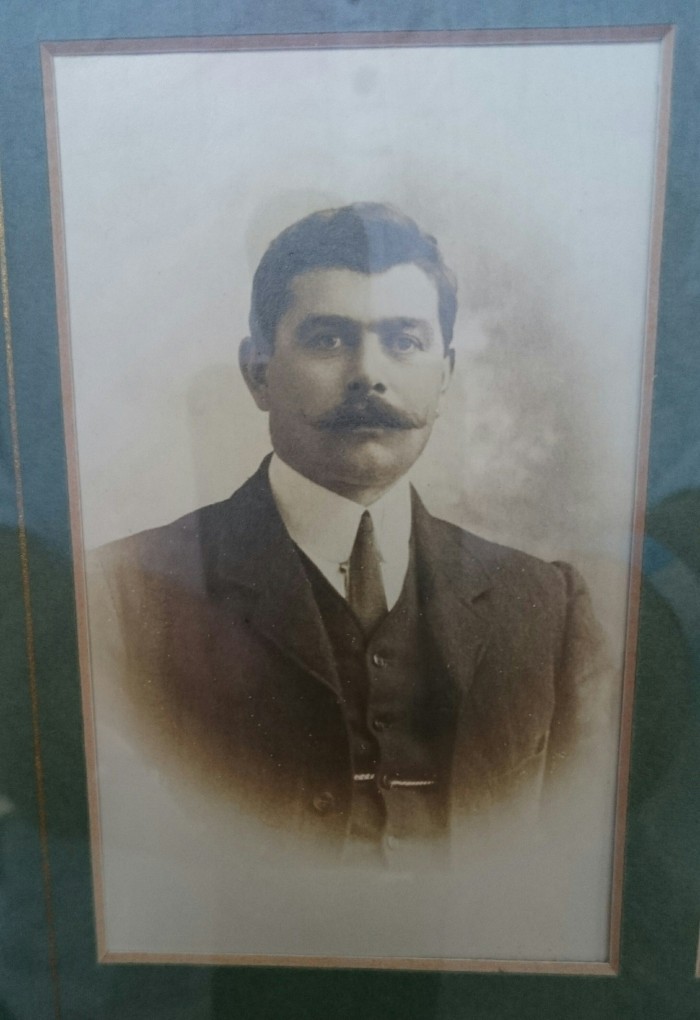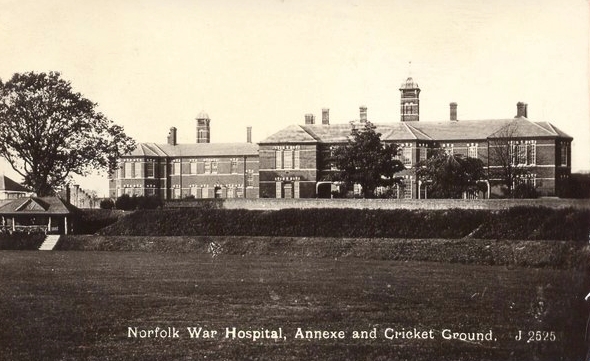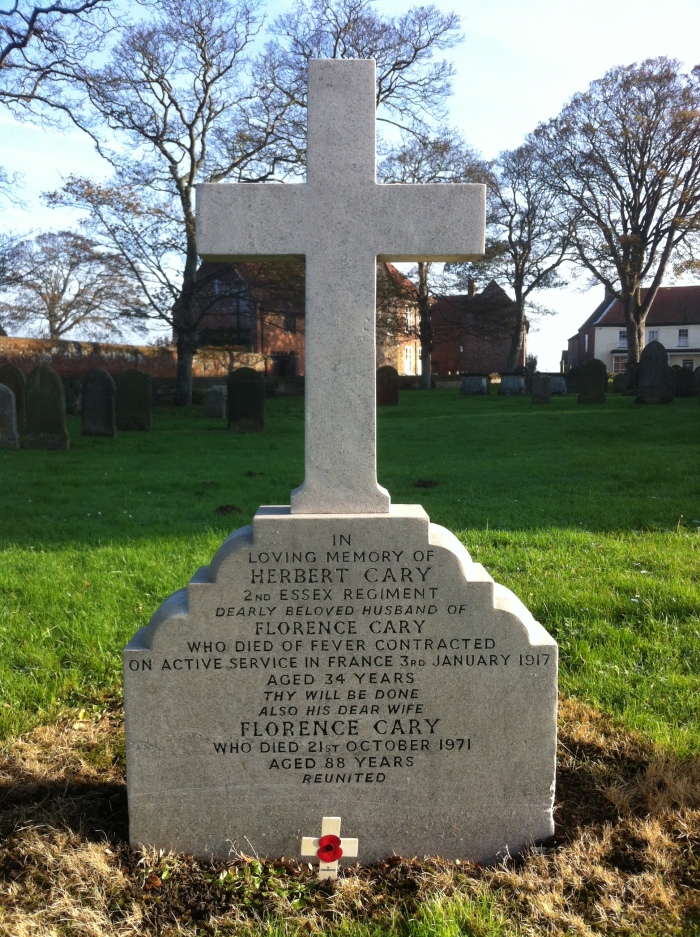
Ernest Brakenbury. This photo was took before the war.
Ernest Alfred Brakenbury was born in 1881 and was the eldest son of Alfred and Anna Brakenbury who in turn had five other sons Arthur, Edwin, Victor, George and William. We will come onto George later on in 2017, but it is known that William also served in WWI. Ernest’s trade was listed as a coal carter during the 1911 Census.
Ernest joined the 8th Bedfordshire Regiment and we can also state that he did not go to war, at the very earliest, until January 1916. The 8th Bedfordshires had moved from the 24th Division to the 6th Division in October of 1915 and they had seen action on the Somme. We cannot pinpoint when he joined them, but he would have been part of a draft to make up for losses somewhere in this timeline. By December 1916, they were in trenches at Givenchy les la Bassée situated to the east of Bethune.
I have recorded the entire war diary for December 1916, as this was the month that Ernest was wounded.
1st December
Le Quesnoy Battalion training. Billets inspected by Corps Commander.
2nd December
Trenches at Givenchy-les-la-Bassee. Relieved 1/The Buffs in left sub sector of 16 IB front at GIVENCHY. A, B & C Coys in front line with D Coy in support in redoubt and keeps. Day cold & misty. Enemy quiet. At night enemy machine guns on back area especially near WINDY CORNER.
3rd December
In trenches as above. Enemy trench mortars aggressive during afternoon. Our snipers claim a hit at 10 a.m. – Officers patrol under Capt Body passed through gap in craters – entered German trenches, surprised and shot a sentry and then retired to our lines. Enemy trenches reported in good condition, wire bad.
4th December
In trenches as above. Enemy trench mortars aggressive during afternoon. Enemy working party 20 strong caught by our Lewis Gunners just after dark. Cries of pain denoting casualties were heard. Our snipers claim a hit today on German peering over parapet. Casualties 4 O.R. wounded.
5th December
In trenches as above. Enemy trench mortars bombarded our left front coy area between 3.30 am & 4.30 am. No damage done. Enemy attempts to dig trench near RED DRAGON CRATER impeded by indirect fire from machine gun and rifle grenades. Casualties 2 O.R. killed.
6th December
Pont Fixe road support trenches In trenches as above. Enemy quiet. Hostile patrol dispersed near THE GAP by our Lewis Gun at 7 a.m. Relieved by 1/The Buffs in the afternoon and moved back into support on the PONT FIXE ROAD.
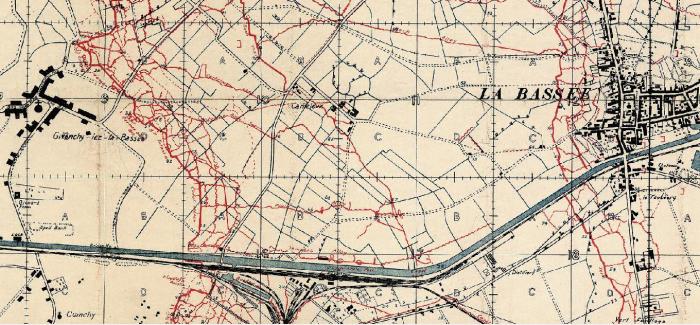
The trenches around Givenchy-les la-Bassee.
7th December
Battn in Support keep and billets. Working parties furnished to work on front line system.
8th December
In support as above. Working parties furnished on front line system.
9th December
In support as above. Working parties furnished on front line system.
10th December
Front line trenches Givenchy-les-la-Bassee Relieved 1/The Buffs in left sub sector. Enemy trench mortars aggressive during afternoon. Working party dispersed by one Lewis guns at night, one hit registered by our snipers. No casualties.
11th December
In trenches as above. Enemy very quiet except for a little trench mortar fire. Snipers claim a hit from TURNERS POST. Germans suspected to be occupying old trenches near RED DRAGON CRATER at stand to arms as whispering coughing & stamping of feet heard from that point. No casualties.
12th December
In trenches as above & Enemy quiet, apparently due to inclement weather damaging his trenches. Patrols report Germans reclaiming their old line near lip of craters. No casualties.
13th December
In trenches as above. Enemy field guns & mortars active during evening otherwise quiet. machine guns & snipers less active. Casualties 2 O.R. wounded.
14th December
Le Quesnoy relieved by 1/The Buffs and moved back into billets at LE QUESNOY.
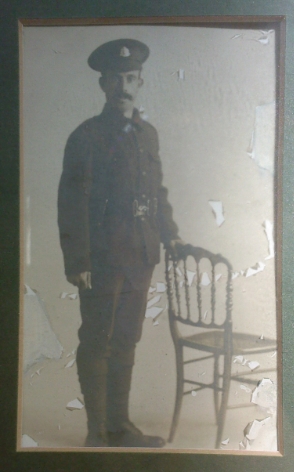
Ernest in uniform and this comes from the WW1 montage in Worstead church.
15th December
Battn bathed and changed underclothing. Working parties at night on line.
16th December 1916
Coys training. Inspection of arms by Bde. Armourer. Working parties at night.
17th December
Church service in Soldiers’ Club hut and working parties.
18th December
Front line trenches near Givenchy-les-la-Bassee Relieved 1/The Buffs in left subsector GIVENCHY. Enemy trench mortars active from 12.30 pm to 1.30 pm. Damage done to our trenches and saps considerable but no casualties. Night quiet. Enemy heard busy pumping and transport heard at 12.25 am and again at 2.30 a.m.
19th December
In trenches as above. Enemy non-aggressive except for short trench mortar bombardment & rifle grenades. Casualties 1 OR killed, 2 OR wounded.
20th December
In trenches as above. Quiet day and night. Enemy busy working during night on his trenches.
21st December
In trenches as above. machine guns and snipers not active. Relief expected to have taken place. Uneventful day & night.
22nd December
Bethune. Relieved in trenches by 1/K.O.S.B. and moved back into billets at BETHUNE.
23rd December
Battalion cleaning up and kit inspection. Baths and change of underclothing.
24th December
Presentation of medal ribbons by Corps Commander to Capt J E Black M.C. (RAMC) Lt W.J.Holbrook MC and military medalists Ptes Aston, Nottingham & Thurgrove.
25th December
Voluntary communion service. The battalion had a splendid Xmas dinner owing to the kindness of the Bedford Comfort Fund.
26th December
Companies route marching.
27th December
Coys training. Draft 151 strong inspected by Commanding Officer.
28 December
Noyelles-les-Vermelles. Marched to NOYELLES and accommodated in Hutment camp. 16 I.B. took over HOHEZOLLERN SECTOR. Battalion in reserve.
29th December
Companies training. Draft practised in use of box respirators.
30th December
Companies training.
31st December
Service was held in NOYELLES.
8th Bedfordshire Regt Field State
Killed 3 Wounded 10 Sick to Hospital 48 Sick from Hospital 36 Evacuated from F.A. 38 Strength of A Coy 11 Officers 225 Other Ranks Strength of B Coy 5 Officers 215 Other Ranks Strength of C Coy 8 Officers 216 Other Ranks Strength of D Coy 5 Officers 210 Other Ranks
Total 29 Officers 866 Other Ranks
From the war diary, National Archives Ref No WO 95/1611
This shows that Ernest was one of ten soldiers who were wounded on either the 4th, 13th or 19th December 1916 as the war diary for the beginning of January 1917 does not record any soldiers being wounded before he died of his wounds on the 13th January.
He must have been stable enough to be moved to No 13 Base Hospital in Boulogne but succumbed to those wounds there and now lies in grave VIII. C. 178 in Boulogne East Cemetery. He was 35 years old.

